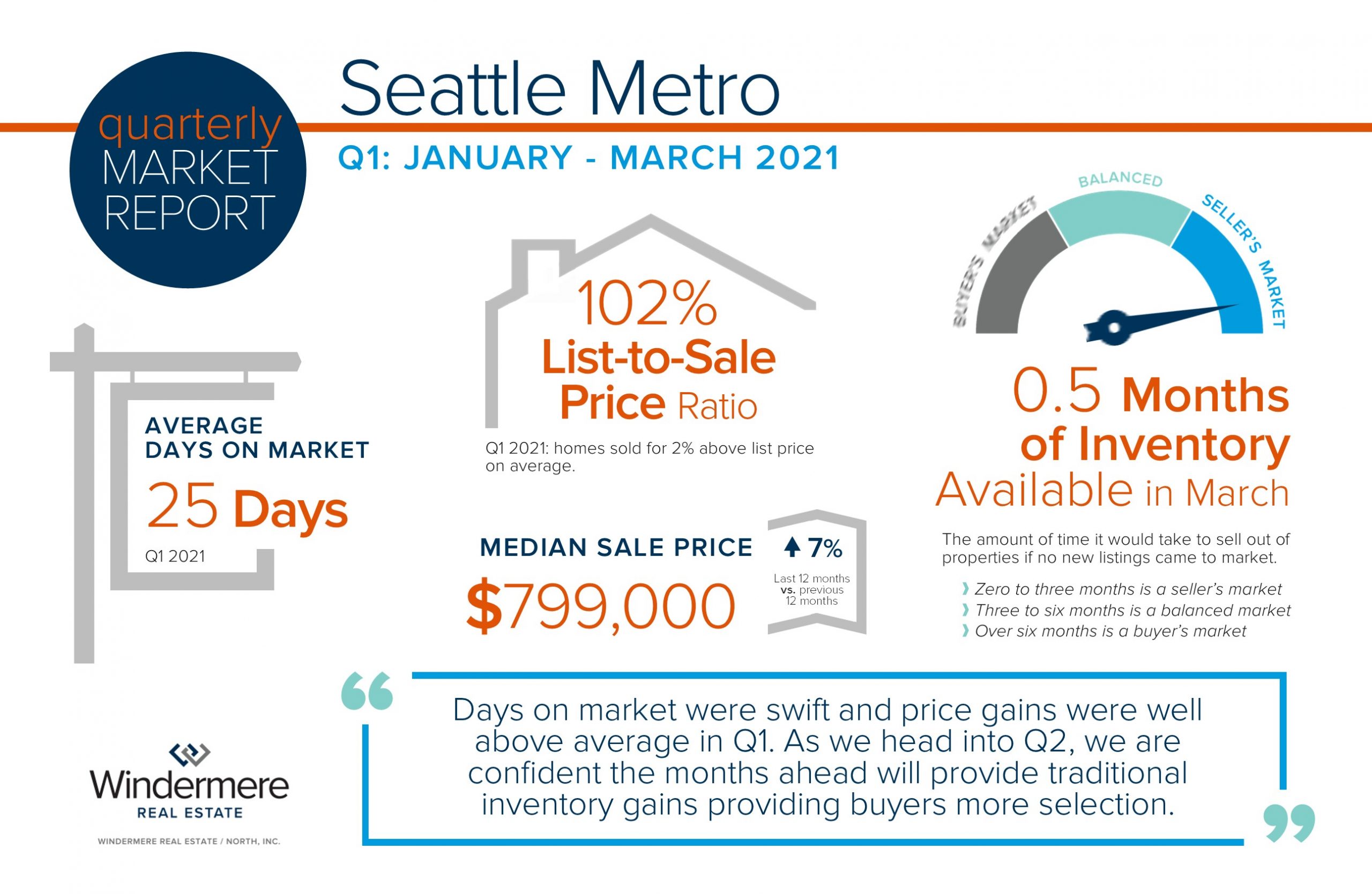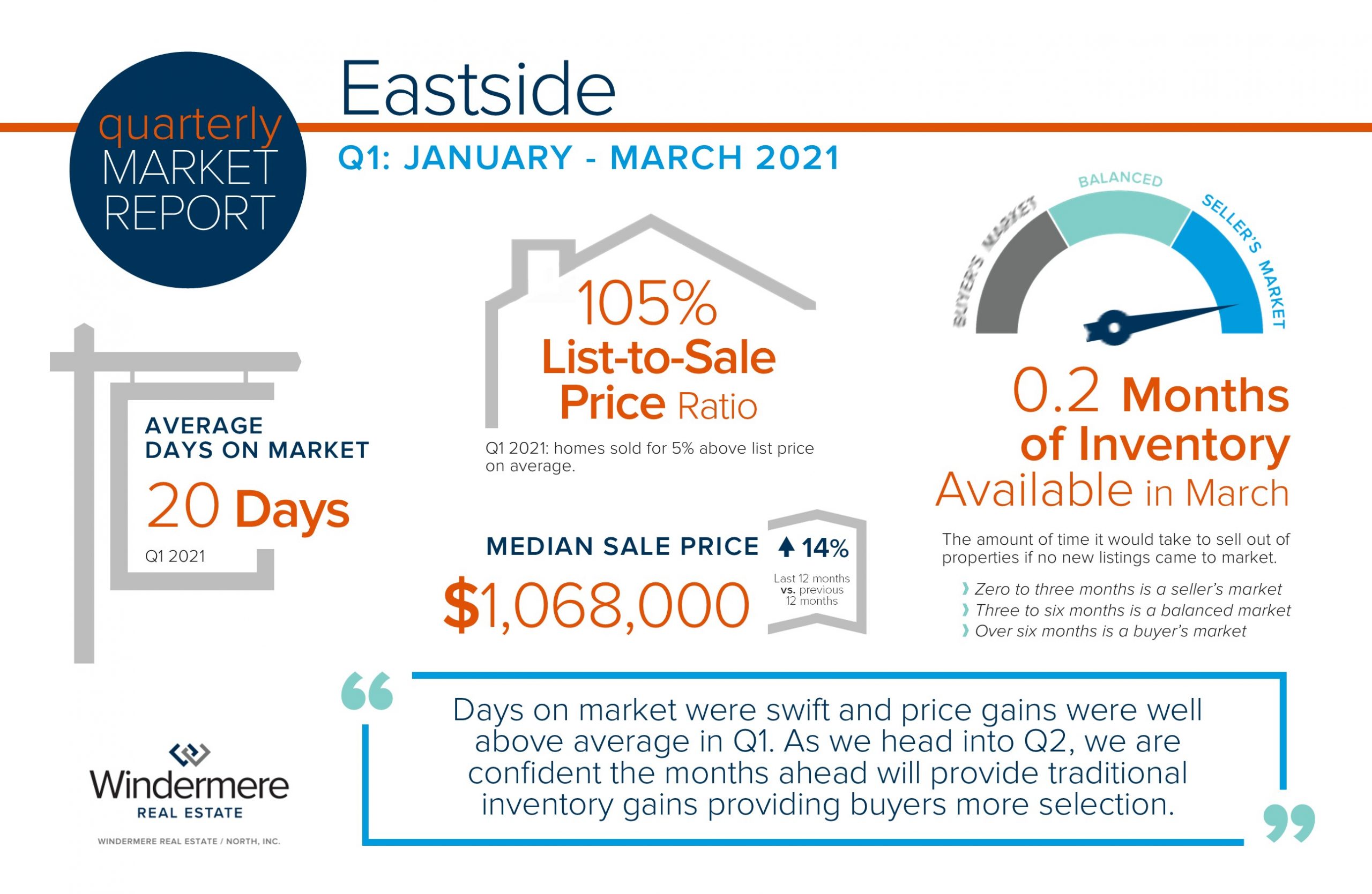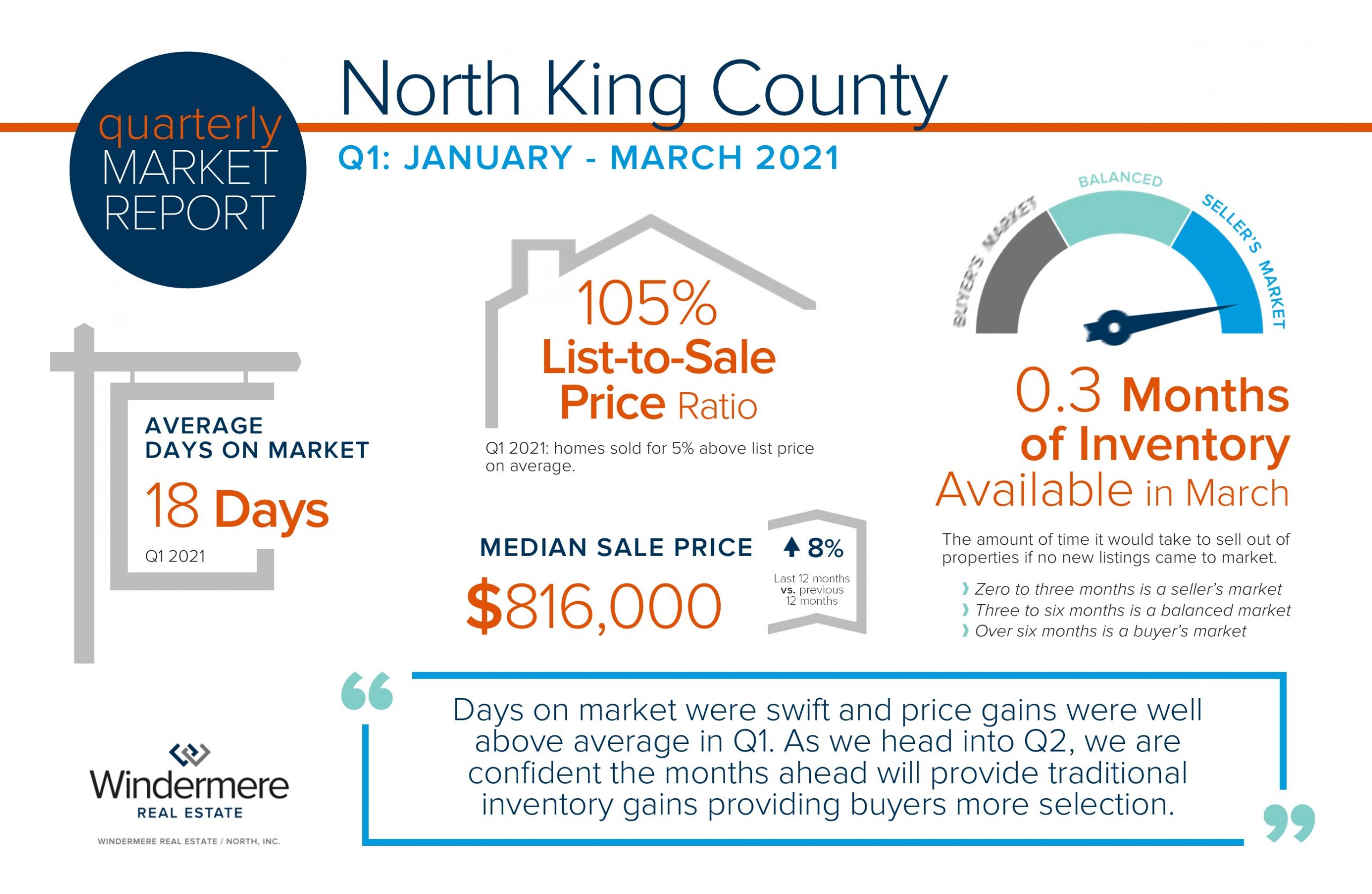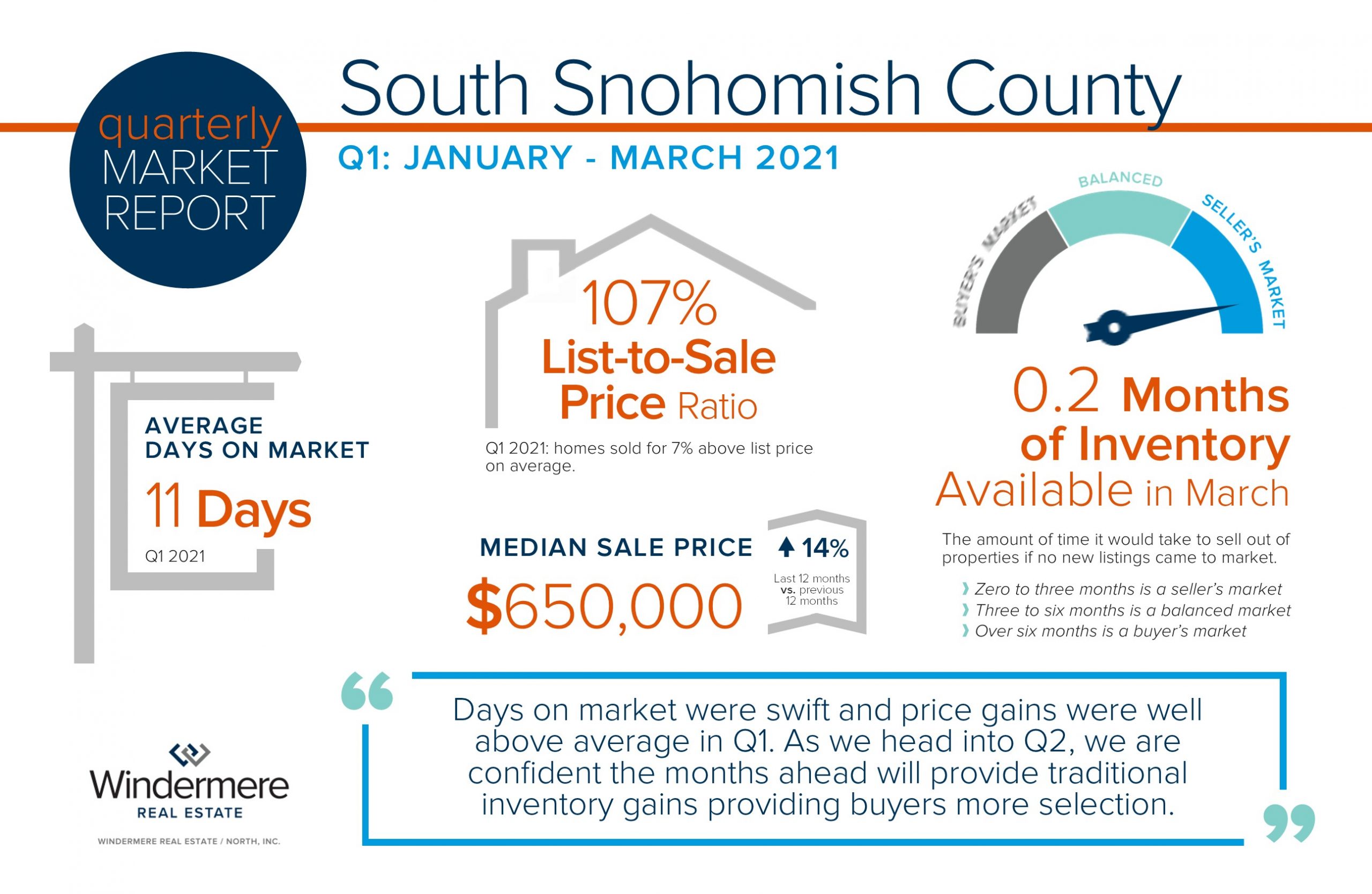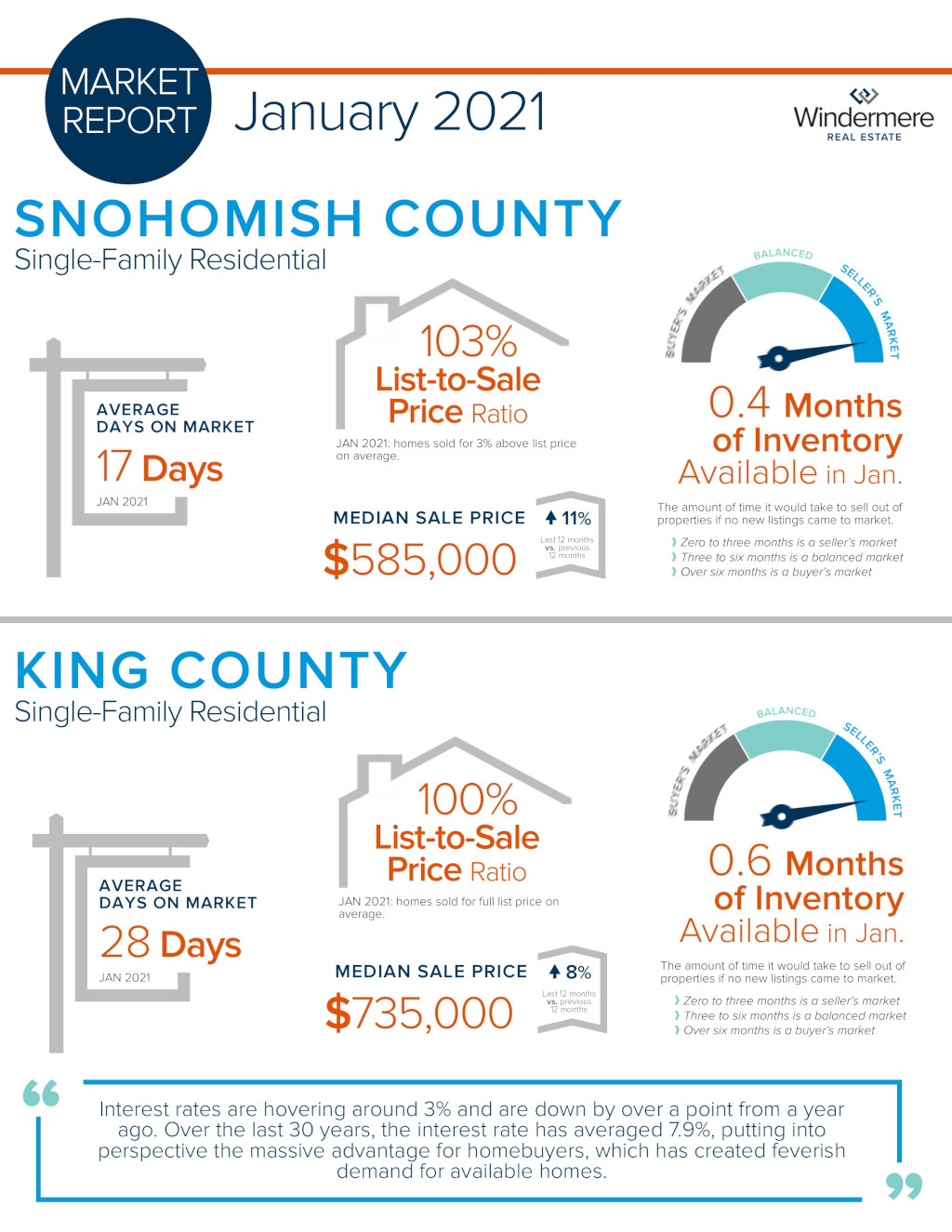Seattle Metro Quarterly Market Trends – Q1 2021
Q1 2021 signified a measurable shift in the real estate market. Demand since the first of the year has been brisk, proving Q1 2021 to be one of the most impactful times in market history! Interest rates remain historically low, helping to offset the cost of price appreciation. Rates and the lucrative tech-influenced job market have helped pending sales outpace new listings.
Additionally, the convergence of Millennials, Gen Xers, and Baby Boomers making big lifestyle moves due to the low cost of debt service, work-from-home options, and formidable equity has the market frothy. Nationally, 30% of all homeowners have over 50% equity in their home, leading people to make moves with large down payments.
Days on market were swift and price gains were well above average in Q1. As we head into Q2, we are confident the months ahead will provide traditional inventory gains providing buyers more selection. We would welcome a tempering in price growth as it has been abundant and is affecting affordability. If you or someone you know is curious about how today’s real estate market relates to your financial and lifestyle goals, please reach out. It is my mission to help keep my clients informed and empower strong decisions.
Eastside Quarterly Market Trends – Q1 2021
Q1 2021 signified a measurable shift in the real estate market. Demand since the first of the year has been brisk, proving Q1 2021 to be one of the most impactful times in market history! Interest rates remain historically low, helping to offset the cost of price appreciation. Rates and the lucrative tech-influenced job market have helped pending sales outpace new listings.
Additionally, the convergence of Millennials, Gen Xers, and Baby Boomers making big lifestyle moves due to the low cost of debt service, work-from-home options, and formidable equity has the market frothy. Nationally, 30% of all homeowners have over 50% equity in their home, leading people to make moves with large down payments.
Days on market were swift and price gains were well above average in Q1. As we head into Q2, we are confident the months ahead will provide traditional inventory gains providing buyers more selection. We would welcome a tempering in price growth as it has been abundant and is affecting affordability. If you or someone you know is curious about how today’s real estate market relates to your financial and lifestyle goals, please reach out. It is my mission to help keep my clients informed and empower strong decisions.
North King County Quarterly Market Trends – Q1 2021
Q1 2021 signified a measurable shift in the real estate market. Demand since the first of the year has been brisk, proving Q1 2021 to be one of the most impactful times in market history! Interest rates remain historically low, helping to offset the cost of price appreciation. Rates and the lucrative tech-influenced job market have helped pending sales outpace new listings.
Additionally, the convergence of Millennials, Gen Xers, and Baby Boomers making big lifestyle moves due to the low cost of debt service, work-from-home options, and formidable equity has the market frothy. Nationally, 30% of all homeowners have over 50% equity in their home, leading people to make moves with large down payments.
Days on market were swift and price gains were well above average in Q1. As we head into Q2, we are confident the months ahead will provide traditional inventory gains providing buyers more selection. We would welcome a tempering in price growth as it has been abundant and is affecting affordability. If you or someone you know is curious about how today’s real estate market relates to your financial and lifestyle goals, please reach out. It is my mission to help keep my clients informed and empower strong decisions.
South Snohomish County Quarterly Market Trends – Q1 2021
Q1 2021 signified a measurable shift in the real estate market. Demand since the first of the year has been brisk, proving Q1 2021 to be one of the most impactful times in market history! Interest rates remain historically low, helping to offset the cost of price appreciation. Rates and the lucrative tech-influenced job market have helped pending sales outpace new listings.
Additionally, the convergence of Millennials, Gen Xers, and Baby Boomers making big lifestyle moves due to the low cost of debt service, work-from-home options, and formidable equity has the market frothy. Nationally, 30% of all homeowners have over 50% equity in their home, leading people to make moves with large down payments.
Days on market were swift and price gains were well above average in Q1. As we head into Q2, we are confident the months ahead will provide traditional inventory gains providing buyers more selection. We would welcome a tempering in price growth as it has been abundant and is affecting affordability. If you or someone you know is curious about how today’s real estate market relates to your financial and lifestyle goals, please reach out. It is my mission to help keep my clients informed and empower strong decisions.
Local Farmer’s Markets 2021
When you shop at a local Farmers Market, you’re buying outstanding freshness, quality and flavor. Knowing exactly where your food comes from and how it was grown provides peace of mind for your family. Plus, you’re supporting a sustainable regional food system that helps small family farms stay in business; protects land from over-development, and provides the community with fresh, healthy food. Find one near you on the list below!
SOUTH SNOHOMISH
Arlington Farmers Market
Legion Park: 114 N. Olympic Ave
Saturdays. 10am-2pm
May 8 — September 25
Bothell Park Ridge Community Market
Park Ridge Church: 3805 Maltby Road, Bothell
Wednesdays 4pm-8pm
June 2—September 29
Edmonds Garden Market
Historical Museum: 5th & Bell Street
Saturdays 9am-2pm
May 1—June 12
Edmonds Summer Market
Downtown: 5th St from the fountain
Saturdays 9am-2pm
June 19—October 9
Everett Farmers Market
2930 Wetmore Ave
Sundays 11am-3pm
May 9—October 31
Marysville Farmer’s Market
Grocery Outlet: 9620 State Ave
Sundays 12pm-6pm
April 18—September 26
Monroe Farmer’s Market
Galaxy Theater: 1 Galaxy Way
Wednesdays 2:30pm-7pm
May 26-September 1
Snohomish Farmers Market
Cedar Ave & Pearl St.
Thursdays 3pm-7pm
May 6—September 30
EASTSIDE
Bellevue Farmers Market
First Presbyterian: 1717 Bellevue Way NE
Thursdays 3pm-7pm
May 13—October 7
Bellevue Crossroads Farmers Market
East Parking Lot: 15600 NE 8th St
Tuesdays 12pm-6pm
June 1—September 28
Issaquah Farmers Market
Pickering Barn: 1730 10th Ave NW
Saturdays 9am-2pm
May 1—September 25
Juanita Friday Market
Juanita Beach: 9703 NE Juanita Dr
Fridays 3pm-7pm
June 4—September 24
Kirkland Wednesday Market
Marina Park: 25 Lakeshore Plaza
Wednesdays 3pm-6pm
June 2—September 29
Mercer Island Farmers Market
Mercerdale Park: 7700 SE 32nd St
Sundays 10am-3pm
June 7—September 27
Redmond Saturday Market
Redmond Town Center: 7730 Leary Way NE
Saturdays 9am-3pm
May 1—October 30
Sammamish Farmers Market
City Hall Plaza: 801 228th Ave SE
Wednesdays 4pm-8pm
May 5—September 29
Woodinville Farmers Market
DeYoung Park: 13680 NE 175th St
Saturdays 9am-3pm
May 1—September 25
SEATTLE
Ballard Farmers Market
Ballard Ave NW
Sundays. 9am-2pm
YEAR ROUND
Capitol Hill Broadway Farmers Market
E Denny Way (between Broadway & 10th Ave)
Sundays 11am-3pm
YEAR ROUND
Columbia City Farmers Market
37th Ave S & S Edmunds St
Wednesdays 3pm-7pm
May 12—October 13
Fremont Sunday Market
Corner of 3410 Evanston Ave N
Sundays 10am-4pm
YEAR ROUND
Lake City Farmers Market
125th St and 28th Ave NE
Thursdays 3pm-7pm
July 1—September 23
Lake Forest Park Farmers Market
Third Place Commons: 17171 Bothell Way NE
Sundays 10am-2pm
May 9—October 17
Madrona Farmers Market
1126 Martin Luther King Jr. Way
Fridays 3pm-7pm
May 14—October 15
Magnolia Farmers Market
Magnolia Village: 33rd Ave W & W McGraw
Saturdays. 10am-2pm
June 5—September 25
Phinney Farmers Market
Closed for 2021
Queen Anne Farmers Market
W Crockett Street & Queen Anne Ave N
Thursdays 3pm-7:30pm
June 3—October 7
Shoreline Farmers Market
15300 Westminster Ave N
Saturdays 10am-2pm
June 5—October 2
University District Farmers Market
University Way NE
Saturdays 9am-2pm
YEAR ROUND
Wallingford Farmers Market
Meridian Park: Meridian Ave N & N 50th St
Wednesdays 3pm-7pm
June 9—September 29
West Seattle Farmers Market
California Ave SW & SW Alaska St
Sundays 10am-2pm
YEAR ROUND
Newsletter – What is your home worth? Price Appreciation Case Studies in Snohomish & King Counties
Over the last 6 years, the median price for a single-family home in King County has grown by 65%, and in Snohomish County 69%. Above are examples of actual homes sold in late 2015 to early 2016 that also sold in early 2021. Note, they were not remodeled or significantly improved in between sales. These examples show the growth in home values that we have experienced over the last three years due to our thriving local economy. I pulled these examples to show you actual pound-for-pound market data versus the statistical percentages I often quote in these market updates. I thought these examples were pretty telling and quite exciting.
This phenomenon has been driven by interest rates being under 5% for the last five years and under 4% for the last 2 years. In addition to low debt service, the tech-influenced job market has kept the local economy humming. Couple all of this with the convergence of Millennials breaking into the market as first-timers or moving up, Gen-Xers moving up, and Baby Boomers cashing out to the right-size house in our area or relocating altogether, and demand is high. This high demand has put pressure on available inventory, driving up price appreciation.
The more recent influence on home values is the effect of the work-from-home lifestyle on housing. Many companies have announced that post-pandemic they plan to let their employees permanently work from home or do so in a hybrid model. This has changed the preference to be closer to the in-city job centers to avoid a long commute. Now, more and more people are attracted to the suburbs and in some cases more rural settings in order to enjoy larger interior and exterior spaces. According to Matthew Gardner, Windermere’s Chief Economist, over 30% of all homeowners in America have over 50% equity. These moves to the suburbs are also propped up on liquidating their equity elsewhere and utilizing it to make a large down payment on the next purchase. Check-out Matthew’s latest video update here.
I see this as a re-organization of lifestyle propped up by strong equity growth, low debt service, and the flexibility to live further from one’s job. Homes in-city are still experiencing favorable appreciation with the median price up 7% year-over-year in Seattle proper, but there is stronger year-over-year growth in suburban locations. For example, in Lynnwood the median price is up 11% year-over-year. Where this has been a challenge is the typical suburban buyer is now competing with far more buyers for these coveted locations. The former suburban buyer accepted a longer commute for a less expensive home. With commute times a lesser concern, now we have a larger audience vying for homes outside the in-city core, making the suburbs more expensive.
The large price gains might seem familiar to the gains of the previous up market of 2004-2007 that resulted in a bubble, but this environment is much different, which is why we are not headed toward a housing collapse. Previous lending practices allowed people to get into homes with risky debt-to-income ratios, minimal down payments, low credit scores, and undocumented incomes. A large part of why the housing bubble burst 14 years ago was due to people getting into mortgages that were not sustainable, which led to the eventual fall of sub-prime lending and the bubble bursting.
It is supply and demand that is creating these huge gains in prices, not predatory lending. We are starting to see an uptick in homes coming to market which is both seasonal and catch-up from the pause the pandemic created last spring. With the vaccine becoming more and more available, more home sellers will become more comfortable bringing their homes to market. The shake-out of the work-from-home shift will eventually temper as some will choose to stay closer in-city and some employers may revert back to in-person work forces. The suburbs are not for everyone, but for now the puzzle of how housing and lifestyle relate to one another is being re-built.
We are anticipating an increase in inventory as we head into spring and summer which will temper price growth and simmer the frenzy. Many folks who have been waiting out the pandemic to make a move based on retirement or upgrading homes are well-positioned to enter the market. If you are one of those people, I hope these examples provide insight on the increase in home values and how they might pertain to your goals.
Potential buyers might shy away from the market due to affordability. While it is expensive to buy a home in the Greater Seattle area, the people that have become homeowners over the last six years have built some amazing wealth. Interest rates remain low, helping to absorb the cost of a home in our area. Last month, I wrote an article about wanting to sell but needing to also buy, which helped layout some strategies to successfully participate in today’s market. If you or anyone you know is considering making a purchase, it is worth the read.
As we head into the active spring and summer months, if you’d like me to provide you a complimentary Comparable Market Analysis (CMA) on your home so you have a better understanding of your home’s value, I’d be happy to do that. This would be an important component in charting your 2021 financial goals. Please reach out, it is my goal to help keep my clients informed and empower strong decisions.
4211 Alderwood Mall Blvd, Lynnwood
We are partnering with Confidential Data Disposal for our 10th year; providing you with a safe, eco-friendly way to reduce your paper trail and help prevent identity theft.
Bring your sensitive documents to be professionally destroyed on-site. Limit 10 file boxes per visitor.
We will also be collecting donations to benefit Concern for Neighbors food bank. Donations are not required but are appreciated.
Hope to see you there!
**This is a Paper-Only event. No x-rays, electronics, recyclables, or any other materials.
Newsletter – Real-Time Market Update: Where We Are Now February 2020
The 2021 real estate market is off to a very brisk start. Historically low interest rates are driving buyer demand. This is coupled with a needed “catch-up” in available homes for sale. In 2020, we saw a stall in new listings during our normally plentiful spring market due to the pandemic. From April to June of 2020, new listings were only a portion of what would have been typical for that time of year. Where it became tricky was in May of 2020 when buyer activity rebounded, and we started to record higher levels of pending sales in 2020 over 2019. This led to the inventory deficit that we currently find ourselves in.
The stats above for King and Snohomish counties highlight the January statistics. In both markets, prices are up year-over-year and well above average appreciation levels. This is due to the phenomenon described above which is a classic case of supply and demand. This has led to months of inventory remaining tight, with mere weeks’ worth of available homes. Days on market have reduced by 38% in King County and 41% in Snohomish County year-over-year, and homes are consistently selling at or above list price.
What does this market mean for sellers? We have already seen sellers that have come to market in Q1 enjoying large buyer audiences and great results. Note that the stats in the image are closed sales in January, which means most of them went under contract (pending) in December. Transactions that closed over the last 7 days and most likely went pending after the first of the year are recording very favorable results for sellers. For example, in King County, there were 305 closed sales from 2/9/21 to 2/15/21 with average days on market at 24 days and a 108% list-to-sale price ratio. In Snohomish County, there were 101 closings in the same timeframe, with average days on market at 14 days and a 104% list-to-sale price ratio. Tight inventory and motivated buyers are creating these results. As we head into spring, we expect to see more homes come to market which could soften these escalations. This would not be a bad thing as sellers are sitting on 9 years of equity growth and these recent gains have been a bonus.
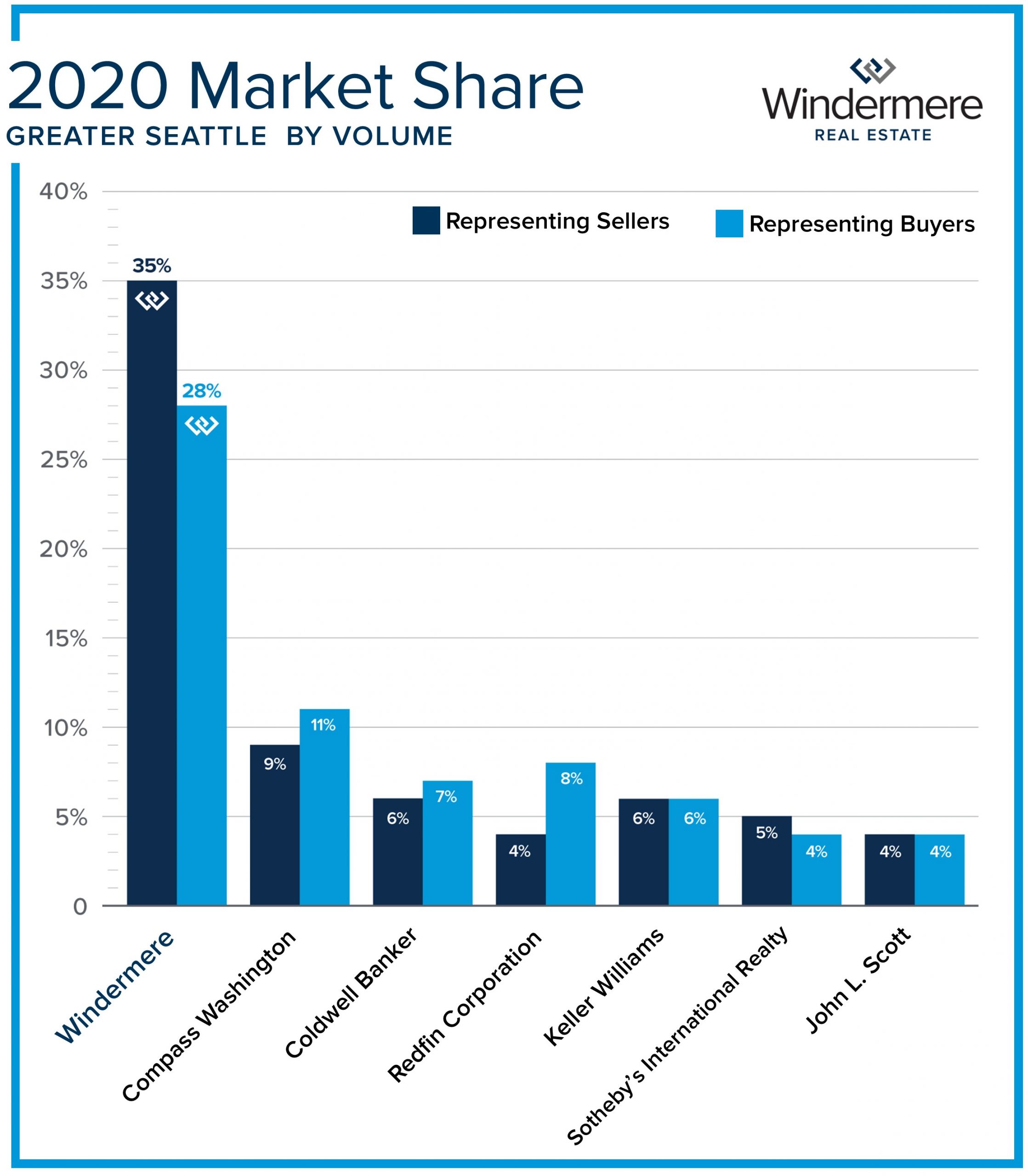 What does this market mean for buyers? Well, you must have a plan! Pre-underwritten financing, pre-offer performed due diligence, organized funds for the down payment, and possible appraisal cushions have been key elements for success. In addition, aligning with a skilled broker to help a buyer prevail is paramount. A responsive broker who is a good communicator can be the difference-maker in winning a home. Listing agents and sellers will not only vet the elements of an offer, but they will also consider the working relationship established with buyers’ brokers as they review offers. There is a special magic to developing these relationships and it takes extra effort. Windermere as a company has been a market leader for many years and continues to work hard to make strong connections for success.
What does this market mean for buyers? Well, you must have a plan! Pre-underwritten financing, pre-offer performed due diligence, organized funds for the down payment, and possible appraisal cushions have been key elements for success. In addition, aligning with a skilled broker to help a buyer prevail is paramount. A responsive broker who is a good communicator can be the difference-maker in winning a home. Listing agents and sellers will not only vet the elements of an offer, but they will also consider the working relationship established with buyers’ brokers as they review offers. There is a special magic to developing these relationships and it takes extra effort. Windermere as a company has been a market leader for many years and continues to work hard to make strong connections for success.
Buyers are anxious to secure their next home with today’s interest rates helping to off-set the expense of price appreciation. With debt service so low, buyers are hungry for more inventory and will most likely start to see an increase in selection in the spring and summer months. Fortitude is the name of the game for buyers, but it will be worth it in the end as the interest rates are amazing and price gains don’t seem to be going away anytime soon.
If you are curious about how today’s market relates to your real estate goals or know someone that needs real estate assistance, please reach out. I am constantly studying the activity in the market to anticipate where we are headed in order to provide sound guidance. It is always my goal to help keep my clients informed and empower strong decisions.
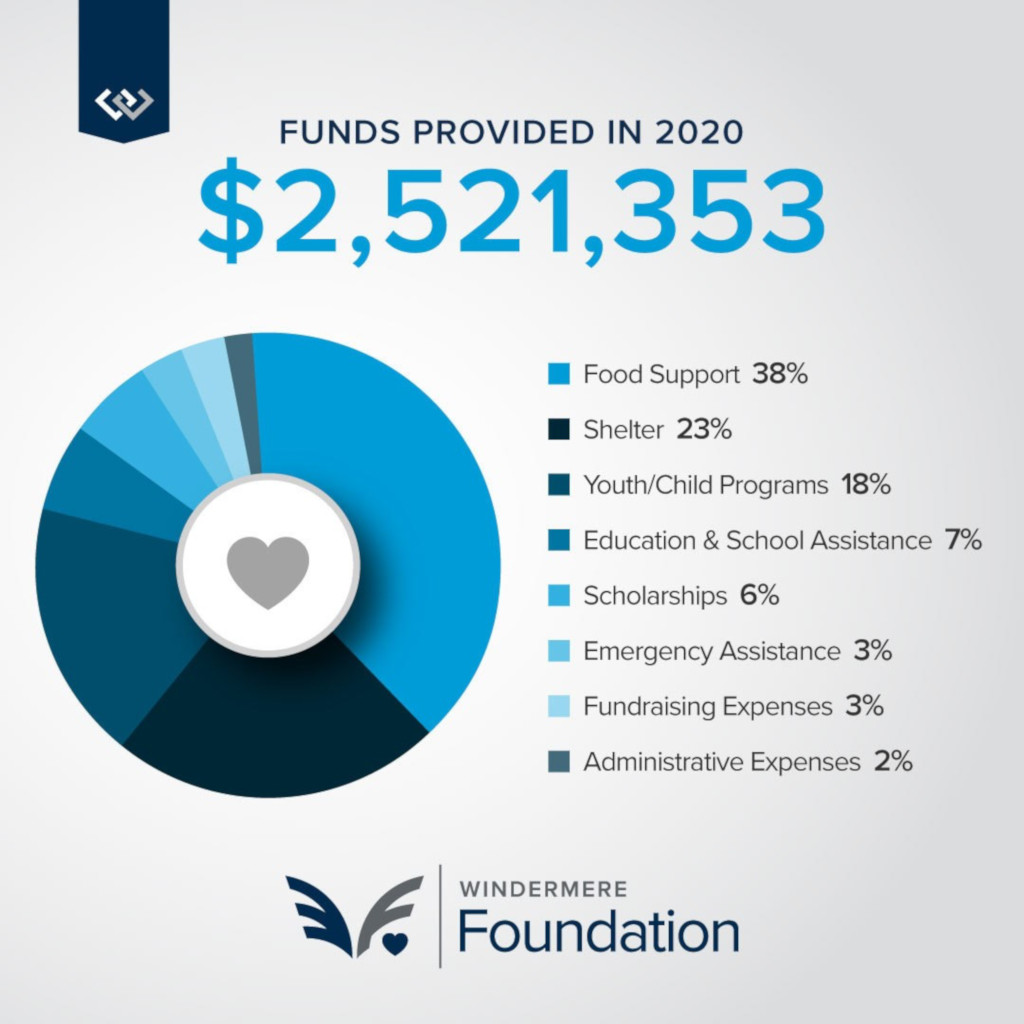 At Windermere, we help people buy and sell homes, but we also help build community. I’m proud to support the Windermere Foundation which has raised over $43 million in the past 32 years for low-income and homeless families right here in our local community.
At Windermere, we help people buy and sell homes, but we also help build community. I’m proud to support the Windermere Foundation which has raised over $43 million in the past 32 years for low-income and homeless families right here in our local community.
In 2020, the Windermere Foundation provided over $2.5M in funds to 569 organizations, while keeping administrative expenses to 2%. The Foundation has been dedicated to helping homeless and low-income families and individuals since 1989. A portion of every commission is donated to this effort along with funds raised from special projects in individual offices.
In 2020, my office donated 5,600 lbs of food and $24K to various food banks associated with The Volunteers of America of Snohomish County as a result of four separate food drives we held throughout the year. We partnered with the YMCA’s Camps Orkila and Colman and donated just over $9K in order to keep the camp operating even though they were not able to open due to the pandemic. This will ensure they will be ready to have kids enjoy the benefits of camp when it is safe. We also sponsored 24 teenage foster boys at Christmas and made sure they had gifts on Christmas morning. We aligned with Pioneer Human Services to create this connection as well as provided grocery gift cards totaling over $3K to eleven families so they could enjoy well-stocked cupboards during the holidays. These opportunities to give back bring purpose to our work and we will continue to work with these organizations in 2021.
Newsletter: Matthew Gardner’s Top 10 Things to Look for in 2021 in the Economy and Our Housing Market

Last week I had the pleasure of attending Matthew Gardner’s 2021 Economic Forecast. Matthew is Windermere’s Chief Economist and coveted expert in our region often called upon by the local and national media for his insights on the economy and housing. Windermere has relied upon his forecasts and advice for over 15 years, and we were lucky to appoint him Chief Economist in 2015. He has been a huge asset to Windermere brokers who utilize his knowledge to help educate their clients in order for them to be empowered to make strong decisions.
Here are Matthew’s Top 10 Things to Look for in 2021:
#1 THE ECONOMY. Matthew expects the economy to continue to recover from the impact caused by the pandemic. He notes that we have already started to see jobs return, but with the vaccine starting to be administered he predicts additional gains in jobs over the second half of the year as businesses start to re-open at full capacity. In addition to jobs, he shared that many Americans have not been spending money like they typically do and have excess cash to spend, leaving many folks eager to travel, make big purchases, or just go out to dinner. The combination of re-opening and more disposable spending will help re-build industries hit hard like entertainment, hospitality, and dining. Supporting small businesses within your community was also something he encouraged consumers to engage with as that will trickle back into the recovery of the overall economy. He expects an increase in spending and additional job creation to boost the economy as we head into spring and summer.
#2 SURGE TO THE ‘BURBS. In 2020 we saw a large number of buyers moving to the suburbs due to the work from home (WFH) phenomenon and affordability. Living in urban areas is more expensive, and with many companies planning on continuing to let their employees WFH indefinitely or half-time moving forward, this has reduced the importance of commute time on a buyer’s wish list. This has also afforded buyers larger homes and yards in comparison to the more compact urban options. Do note however, that Seattle is not losing population, as the net in-migration figure for Seattle in 2020 was up 3.3%.
#3 PREFERRED HOME FEATURES. What buyers are looking for in a home is changing. Open-concept floorplans used to be all the rage, but now buyers are looking for separate spaces where an at-home office or Zoom space can be incorporated. Outdoor living areas are also coveted due to the option for year-round entertaining and/or exercise/home gym space. Rural homes with high-speed internet are coming at a premium as these properties create room to roam and the option to WFH. Not all rural areas have the infrastructure in place to support the technology needed to WFH, so the areas that do are in demand.
#4 INTEREST RATES. In 2020, we broke the all-time low for interest rates 16 times! We are currently under 3% and down an entire point from the previous year. This has fueled demand in all segments of the market, particularly first-time homebuyers, luxury buyers, retirees downsizing, and move-up buyers. Note that a one-point drop in interest rate gives a buyer 10% more buying power, which is helping off-set the expense of price growth. While Matthew anticipates rates rising in 2021, he expects them to settle around 3.1%. With the long-term average at 7.9%, a bump up above 3% is still something to celebrate and will continue to be the gas in the tank of buyer demand.
#5 MORTGAGE FORBEARANCE. In the spring of 2020, the banks were quick to offer the option of mortgage forbearance in response to the job losses created by the pandemic. Many homeowners that needed to, took advantage of this option. The good news is that since May there has been a 43% reduction in participants in the program. Currently, there are 2.7M people in the program, many of which are returning to work and will be able to continue with their mortgage payments. For those that will not be able to afford the monthly payments, the option to sell after double-digit year-over-year price appreciation in markets such as WA, CO, OR, MT, and ID will provide a financial benefit. Matthew disagrees with the naysayers that think we are sitting on the brink of a wave of foreclosures in our region as equity levels are in favor of a homeowner selling vs. giving their home back to the bank. Buyer demand is also at an all-time high ensuring a plentiful homebuyer audience.
#6 HOME PRICES & SALES. Strong buyer demand will continue due to low interest rates and lifestyle moves influenced by the option to WFH and Baby Boomers retiring. Matthew believes we will have an increase in closed sales in 2021 and that we will continue to have price appreciation. Bear in mind that we are coming off above-average year-over-year price appreciation in 2020 (up 12% in Snohomish County & 7% in King County), and he expects price growth to temper in 2021 year-over-year which will help with affordability and rate increases.
#7 LUXURY HOME MARKET. 2020 was an amazing year for the luxury home market, with closed sales over $1M in King and Snohomish Counties up 30% and over $2M up 28%. There was a brief stall in the spring when jumbo loan rates surged and were in some cases unavailable at some banks. By May, jumbo loans found their place in the market, and homebuyers in the upper price points were able to enjoy the historically low interest rates as well. Matthew sees this continuing in 2021 along with more foreign buyers coming to the market with international travel opening back up in the second half of the year.
#8 ZONING. Matthew sees affordability as the biggest challenge in our market and zoning changes are the most efficient way to solve it. He expects legislators to have more discussions about adjusting zoning policies to create more affordable housing. He does not expect this to happen overnight or even in 2021, but for the stage to start to be set to make progress in this arena.
#9 APARTMENT RENTAL MARKET. The pandemic has been rough on the rental market, especially apartment rentals in big cities such as Seattle. The WFH option and a newfound aversion to shared living spaces have driven increases in vacancy rates. This has caused rental rates to decrease, and with an anticipated bumper crop of new apartments set to come to market in 2021 this segment of the market will take some time to recover due to supply and demand. Single-family rentals have fared much better than apartments. We expect the eviction moratorium to be lifted in tandem with increased vaccination rates and the rebound of the job market.
#10 ADAPTIVE REUSE. While the expense to convert apartments to condominiums is cost-prohibitive, he sees some opportunity to convert some hotel spaces to residential living. This goes in-line with creating more affordable housing and could be a positive economic option for motel or inn owners that have suffered during the pandemic. Other adaptive reuse options due to the surge in online commerce would be shopping malls converting to mixed-use (commercial with residential) space, and strip malls being bought out by developers for residential units.
Overall, Matthew’s take on the economy as we head into 2021 is hopeful and on the housing market extremely positive. If you would like the recording of his forecast or the Power Point slides in PDF format to review the data yourself, please reach out. It is always my goal to help keep my clients informed and empower strong decisions.
I am pleased to present the fourth quarter 2020 edition of the Gardner Report, which provides insights into select counties of the Western Washington housing market. This analysis is provided by Windermere Real Estate Chief Economist Matthew Gardner. I hope that this information will assist you with making better-informed real estate decisions. For further information about the housing market in your area, please don’t hesitate to contact me.
Windermere and the Seattle Seahawks partnered for the fifth season to #TackleHomelessness, raising an additional $32,100 for Mary’s Place to support homeless children and families, bringing our total raised to $160,300! Read more on the Windermere blog.
South King County Quarterly Market Trends – Q4 2020
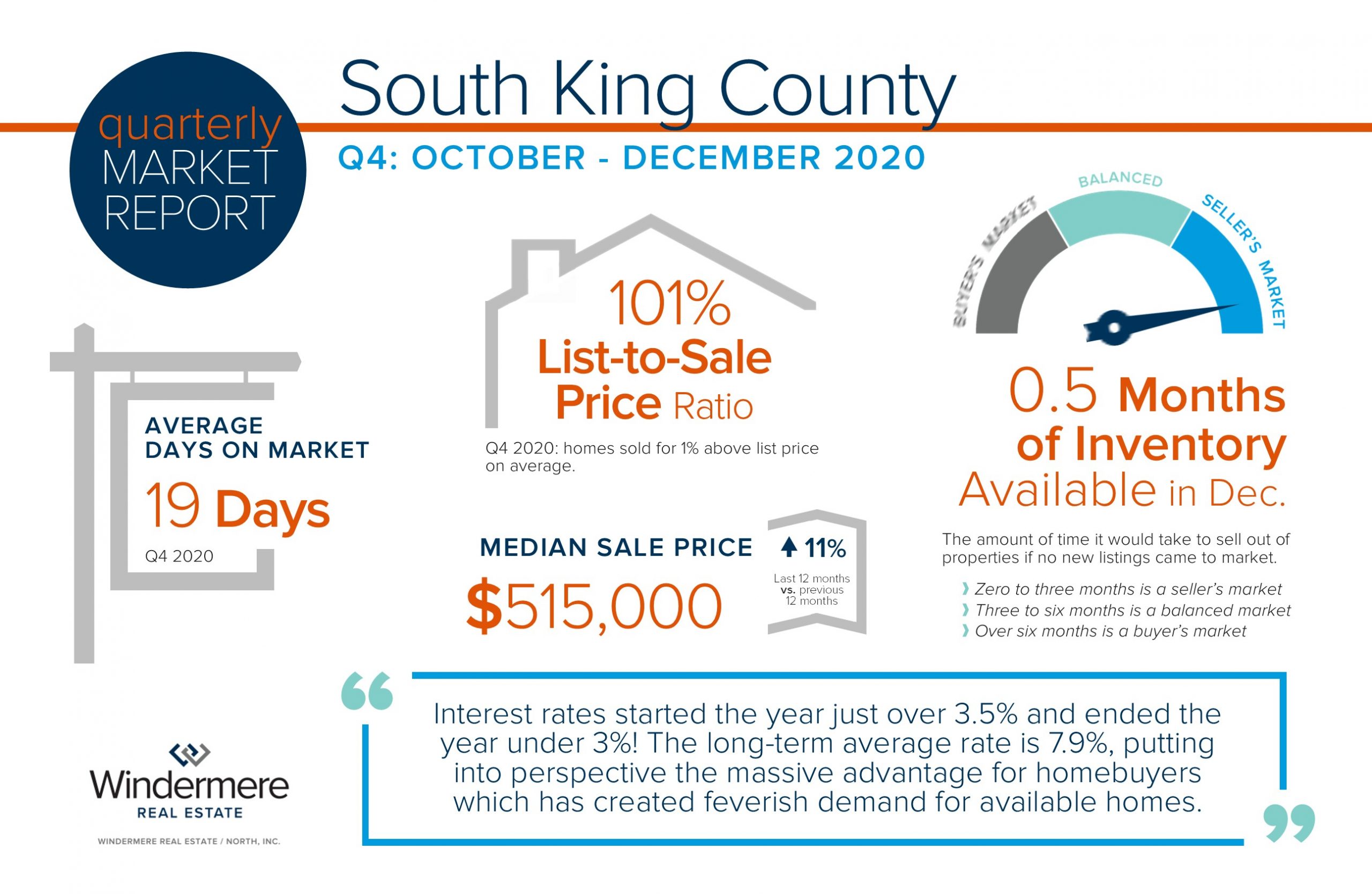
The 2020 real estate market was a bright spot in the economy and the fourth quarter finished strong, with the median price up 11% complete year-over-year. Interest rates started the year just over 3.5% and ended the year under 3%! The long-term average rate is 7.9%, putting into perspective the massive advantage for homebuyers which has created feverish demand for available homes. Even though new listings remained even year-over-year, low interest rates helped drive a 3% increase in closed sales in 2020.
Pandemic-driven moves were spurred by folks working from home, taking early retirement, and in some cases responding to job loss. Remote working eliminated the need to have a home close to work which encouraged people to flee to the suburbs. Eliminating the commute and the desire for larger spaces with outdoor enjoyment quickly moved to the top of peoples’ wish lists. The last 8 years of positive price growth has led to formidable seller equity, enabling early retirement for some and/or the opportunity to liquidate and recover from the negative effects in some employment industries.
We expect rates to stay low in 2021 and with many Millennials coming of age there will continue to be large amounts of homebuyers eagerly waiting for fresh inventory. Ending the year at 0.5 months of inventory is essentially ground zero for selection, putting home sellers in the driver’s seat for now. I will continue to keep you updated throughout 2021 as we navigate these unique times. It is my goal to help keep my clients informed and empower strong decisions; please reach out if I can help.
 Facebook
Facebook
 X
X
 Pinterest
Pinterest
 Copy Link
Copy Link
